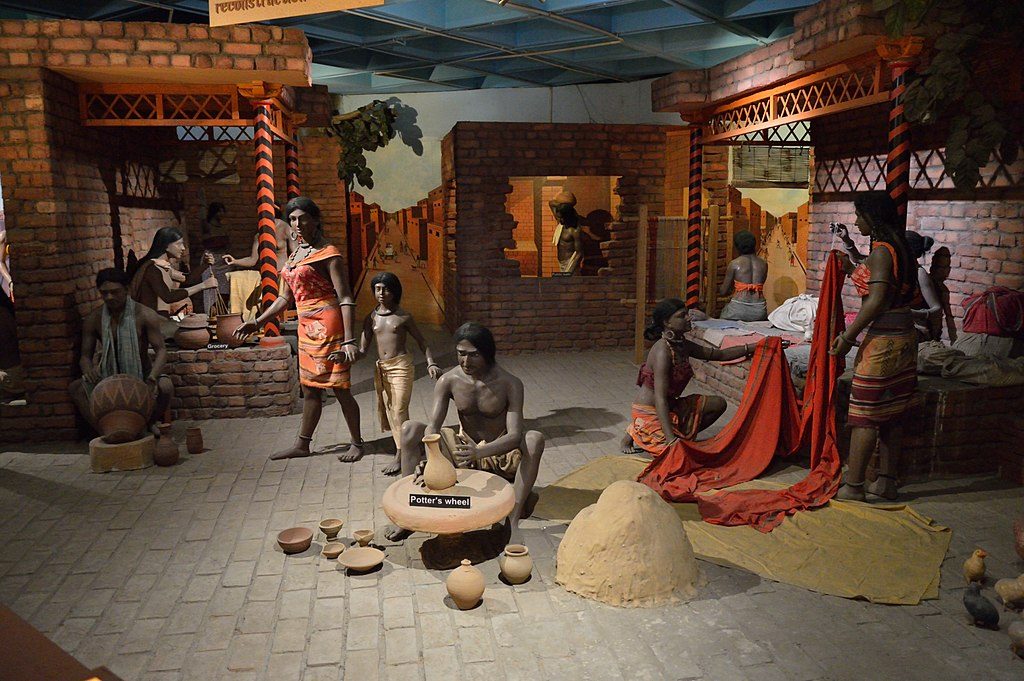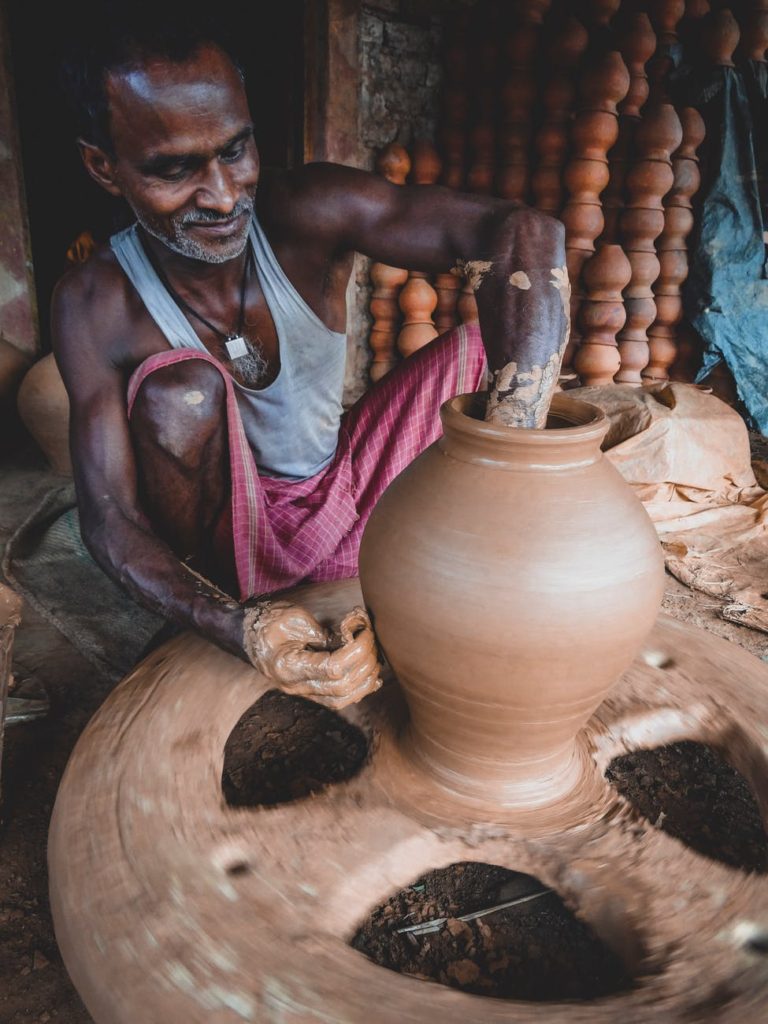Forests, jungles, groves, fields, trees and plants have all been decreed sacred in some or the other form for large sections of humanity. In India, the values of spirituality, sacredness and philosophy are all deep concepts, expressed subconsciously within much of the work done by the practitioners and creators of arts, crafts and textiles. An artist from Mithila was once asked at an exhibition in Frankfurt why the snake was a central piece in so many of her paintings. She answered, “We pray to them as deities so that they do not harm us.” “How wonderful!” responded the visitor, “We would just kill them if they came near us! Your ways are so much more compassionate.” The worship of snakes and the existence of sacred groves for them are examples of the ritualistic processes that evolved from the lives of forest dwellers. Communities living closely with nature, having an intimate understanding of the hierarchies in the food chain, would have felt the need to accord sacredness to all creatures that could harm them, so they may be avoided or propitiated through prayer and ritual. “Unlettered” in the modern sense, traditional wisdoms relate to survival, sustainability and holistic integration of many different facets of the planet, including vegetation, animals, fish, birds, insects as well as resources such as water.
Forest dwellers learned methods of using medicinal plants for their health, and weaving techniques for clothing from the formation of birds’ nests, cobwebs or reeds and rushes. Trees have been imbued with the presence of deities so that they are not cut down indiscriminately, and fields of kauna grass in the wetlands of Manipur, which offer raw material for basket and mat weavers, are given weekly birthdays to avoid the harvesting or cutting of grass. Even today, both farmers and craftspeople observe this, pointing to the old bonds between farmers and artisans in agro-based societies.

Since early humans used stone, wood, soil and grasses as tools, raw materials and instruments, artisanship developed a deep dependence on the organic world. Synthetics of various forms came in only in the late 18th and early 19th centuries, negatively affecting the planet. Until then, the craftsperson’s basic sources were nature’s bounties. They had to cultivate, nurture, replenish and use them judiciously for their own and their community’s needs.
In the upper regions of Arunachal Pradesh, the Tibeto-Burman Mon Pa, a tribal community, traded in yaks because this large mammal provided them with long shaggy hair to weave blankets; gave butter, milk and cheese; and when it had to be killed, one yak would suffice for a whole village instead of having to kill many, like in the case of chickens! The concern for replenishment — need rather than greed — and respect for nature are ingrained in most practices of traditional communities that have not succumbed entirely to the industrial, synthetic world.
In the early days of industrial manufacture, consumers believed that all output was solid, long lasting, or repairable. This is no longer so, as most products now quickly become obsolete. These products, which are all made of synthetic materials, are almost all non-biodegradable. Spare parts are unavailable or discontinued because a new model has taken its place, and you simply have to throw out the old, whether they are computers, telephones or even garments dictated by fashion gurus. In an industrial society, where everything is about rapid change, waste, and extravagance, the artisan who comes from integrated cultural communities and can customise manufacturing by hand, is thrown in the ‘dustbin-of-the-obsolete.’
In craft and culturally integrated communities, rendering obsolete or destroying an object is studied, intentional and sustainable. This is done by building these concepts into festivals, ritualistic activity and mutual concern. Take the simple earthen pot for example. During Divali, the clay workers make everything from large storage pots to small clay diyas, as well as figures of Durga and Lord Ganapati for worship at sundry places. After prayers, the Lord Ganapati statue, as well as the mud pots with clay lamps placed on their lids are carried on the heads of women in procession in Haryana and immersed ceremonially into a flowing body of water to disintegrate ergonomically, while signifying the disintegration and reintegration of all things with the earth. Similarly, the marigold garlands used for prayers must be disposed off in earthen flowerpots or flowerbeds, and not in dustbins. Banana leaves used for prayers or at the edges of wedding mandapams are recycled into fibre for weaving. Coconuts are known for their multipurpose uses including by craftspeople as ladles and containers for painters to keep their mineral colours.

Not only objects, but even communities are closely integrated and cared for in such systems. A beautiful example of community concern for potters happens in Vidarbha in Maharashtra. The people observe a festival called Pola, where potters who have no work prior to harvest bounties, are involved by making miniature cooking utensils for children. The festival is created around the need for potters to be provided a livelihood during the lean period. The tiny earthen utensils are worshiped along with earthen dolls on the Pola festival day, after which they are given to children to play. In a way, it is just an excuse to keep communities busy and is a strong reminder that communal integrity for sound practical reasons like needing to work and earn, are often wrapped in festive rituals that may not have a perceivable meaning to an outsider.
The north eastern states of India and Bengal also have crafts practices that are integral to their lifestyles and local materials. Everything from their homes, bridges, tree guards, sleeping mats, fishing traps, chicken coops, hats, tea strainers, trays and now even drinking straws are made out of bamboo of many different varieties. Houses are of thatch, completing the purely ergonomic, eco-friendly integration of the people’s lives with their habitat and the materials around them, which are renewable and inexpensive. Each member of the family makes all the goods, whether it is their clothing, hand-woven on home-based looms, or basketry for their daily use. They make all these for themselves and for their community or tribe.
Similarly, in any part of India where handloom weaving is an age-old occupation, yarn is stretched along the long narrow lanes used by all. Weavers wake early and stretch the warp threads, preparing them for the looms, as a community activity where 4 to 6 persons are needed for the process. All weavers come out of their homes to help collectively so that a spirit of co-operation is built into their way of life.

Young members of the family help with smaller, simpler activities like rolling balls of thread, wetting clay, spread out material to dry, and generally observing their elders as they work on their crafts, so that transference of knowledge is fluid and natural. Even though the children are away during school hours, they readily assist their elders when they return home. Storytelling in the form of songs and poems have also been an important form of ensuring that the teachings are passed on with reverence and respect. Songs in Ladakh celebrate deities and spirits living in trees, and are passed on from one generation to the next, to prevent people from cutting the trees for fuel. Woodcutters elsewhere followed practices delineated in the Shilp Shastras [ancient texts describing the design rules, principles and standards of art and craft] requiring them to rub honey and milk on the blade of their axe and asking forgiveness from the tree for having to harm them for the sake of their own livelihoods.
Urban societies and policy makers never count such transference of traditional knowledge and practices as the learning of skills for free. Other professions need to be learned at a cost: Fees have to be paid, equipment and books bought, and certificates obtained. In the craft world, children of craftspeople learn for free and no one gives credit or assistance to acknowledge this.
However, we have started seeing an integration of the knowledge of craftspeople and the modern market systems in many parts of the world. In Meghalaya, for instance, farmers have a natural plant that grows around their fields. The plant, locally known as Ramie (scientific name: Bohemeria nivea), is known to be one of the strongest plant fibres, even when it is wet. Locals used to fry its leaves into a vegetable dish and use the fibres to make fishing nets. With some technological intervention, the fibres are now being converted into textile and being tried out to make fashion garments, upholstery and even cloth jewellery and perfume. This has created considerable co-operation between the farming community and fibre processors, extending as far as weavers in Assam and outwards to the fashion world. Integration processes happen best when begun from the bottom, after which it is easier to embrace modern technology and reach out to the industrial world. There are hundreds of natural grasses of this nature in India that await processing technology for value-addition.
The most important aspect of inclusiveness and integration of our ecosystems is the ease with which crafts people adapt to change, new ideas, and unfamiliar environments. They have wisdoms to share, and ways of organised working among themselves even as they work as family units. Tribal communities work in pairs and co-operatives have been imposed and have almost rotted away because of corruption. Self-help groups (SHGS) are bringing women working together in a new form of collective organisation, and in some cases old style karkhanas, ateliers, still operate (as in Kashmir). Corporates like Ikea are setting up durry weavers in work sheds in Uttar Pradesh, while village groups are organised under umbrellas of NGOs. The forms of organisation are as varied and flexible as crafts production itself.
A much deeper and urgent study in India of the relationship between craft production and the reduction of man’s carbon footprints and non-biodegradable materials will be greatly beneficial for future generations, both for the survival of indigenous livelihoods, knowledge, heritage and the planet itself.
